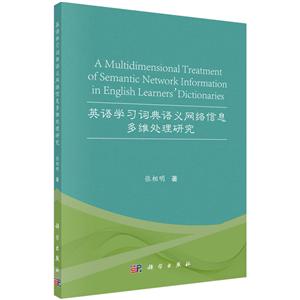英语学习词典语义网络信息多维处理研究 版权信息
- ISBN:9787030576279
- 条形码:9787030576279 ; 978-7-03-057627-9
- 装帧:一般胶版纸
- 册数:暂无
- 重量:暂无
- 所属分类:>
英语学习词典语义网络信息多维处理研究 本书特色
本书以词汇语义学为理论框架,以英语学习词典的语义网络信息处理为研究对象,从编者、用户、专门词典和呈现方式等四个视角对比剖析了当前英语学习词典语义网络信息处理现状,并以此为基础构建了多维语义网络处理模式(MSNTM),再进一步分析了该模式在二语词汇习得、词典使用、词典编纂等方面的应用和启示。研究发现,国内英语学习词典在语义网络信息呈现方面存在信息量偏少和方式单一等不足;MSNTM涵盖语义关系、词典结构、呈现方式等要素,有助于英语学习词典全面、有效地呈现语义网络信息。
英语学习词典语义网络信息多维处理研究 内容简介
本书以词汇语义学为研究视角,以英语学习词典的语义网络信息处理为研究对象,从编者、用户、语义词典和呈现方式等四个不同视角剖析了当前英语学习词典语义网络信息处理现状,并在基础上构建了"多维语义网络处理模式"(MSNTM),再进一步分析了该模式在二语词汇习得、英语学习词典使用、英语学习词典编纂等方面的启示和应用。本研究发现:靠前英汉学习词典在语义网络信息呈现方面存在信息量偏少和方式单一等不足;多维语义网络处理模式涵盖语义关系、词典结构、呈现方式等要素,可以帮助英语学习词典中全面、有效地呈现词目的语义网络信息。
英语学习词典语义网络信息多维处理研究 目录
序
前言
List of Figures
List of Tables
Abbreviations
Chapter 1 Introduction
1.1 Semantic Network Information in a Dictionary
1.2 Explorative Questions and Operative Framework
1.3 Main Terms Used in This Book
1.4 Outline of This Book
Chapter 2 English Learners' Dictionaries and Semantic Network
2.1 Introduction
2.2 English Learners' Dictionaries
2.2.1 The Structure of a Learners' Dictionary
2.2.2 Western Studies on English Learners' Dictionaries
2.2.3 Domestic Studies on ELDs
2.3 Semantic Network
2.3.1 Semantic Network and Semantic Relations
2.3.2 Semantic Network and Vocabulary Acquisition
2.3.3 Semantic Network and Lexicography
2.4 Summary and Implications
Chapter 3 Lexical Semantics
3.1 Introduction
3.2 What Is Lexical Semantics?
3.2.1 Lexical Semantics: Definitions
3.2.2 Lexical Semantics: Research Objects
3.3 Lexical Semantic Study in the West
3.4 Lexical Semantic Study in China
3.5 Lexical Semantics and Lexicography
3.6 Lexical Semantics in Psycholinguistics: Mental Lexicon
3.6.1 What Is Mental Lexicon?
3.6.2 Model Structure of Mental Lexicon
3.6.3 Mental Lexicon and Vocabulary Acquisition
3.6.4 Mental Lexicon and a Dictionary
3.7 Summary
Chapter 4 A Comparative Study of Semantic Network Treatment in EELDs and ECLDs: The Compilers' Perspective
4.1 Introduction
4.2 Semantic Network Comparison in the Megastructure Level
4.2.1 Front Matter
4.2.2 Back Matter
4.2.3 Middle Matter
4.3 Semantic Network Comparison in the Microstructure Level
4.4 Semantic Network Comparison in the Mediostructure Level
4.5 Summary 79
Chapter 5 An Empirical Study of Semantic Network Treatment in EELDs and ECLDs: The Users' Perspective
5.1 Introduction
5.2 Purposes and Questions of the Questionnaire Survey
5.3 Results and Discussion
5.3.1 Results of the Respondents' Background Information Survey
5.3.2 Results of the Semantic Network Information Survey
5.3.3 Results of the Semantic Network Information Acquisition Survey
5.3.4 Results of the Semantic Network Information Treatment Survey in ELDs
5.4 Summary
Chapter 6 An Explorative Study of Semantic Network Treatment in Semantic Dictionaries: The Specialized Dictionaries' Perspective
6.1 Introduction
6.2 WordNet
6.2.1 What Is WordNet?
6.2.2 Semantic Network Treatment in WordNet
6.3 Longman Language Activator
6.3.1 What Is Longman Language Activator?
6.3.2 Semantic Network Treatment in LLA
6.4 Roget's Thesaurus
6.4.1 What Is Roget's Thesaurus?
6.4.2 Semantic Network Treatment in Roget's Thesaurus
6.5 Summary
Chapter 7 An Investigative Study of Semantic Network Treatment in EDs: The Presentation Manners' Perspective
7.1 Introduction
7.2 EDs and Electronic Lexicography
7.3 Semantic Network Treatment in EDs
7.3.1 OALD9 Online
7.3.2 LDOCE6 Online
7.3.3 MED2 Online
7.3.4 Wordsmyth
7.3.5 WordReference
7.3.6 Lexical FreeNet
7.4 Summary
Chapter 8 A Multidimensional Model of Semantic Network Treatment in ELDs
8.1 Introduction
8.2 Structure Components of a Semantic Network Treatment Model
8.2.1 Semantic Relations
8.2.2 Structure Components of a Dictionary
8.3 A Multidimensional Model of Semantic Network Treatment in ELDs
8.3.1 Megastructure
8.3.2 Microstructure
8.3.3 Mediostructure
8.3.4 The Multidimensional Semantic Network Treatment Model
8.4 Summary
Chapter 9 Applications and Implications of MSNTM
9.1 Introduction
9.2 Applications and Implications for L2 Vocabulary Acquisition
9.2.1 Implicit and Explicit Vocabulary Acquisition
9.2.2 Incidental and Intentional Vocabulary Acquisition
9.2.3 Vocabulary Acquisition by Means of Semantic Network
9.3 Applications and Implications for ELD Use
9.4 Applications and Implications for ELD Compilation
9.5 Summary
Chapter 10 Conclusions
References
Appendixes
Appendix Ⅰ Questionnaire (English Version) Semantic Network Information and Its Treatment in ELDs
Appendix Ⅱ 调查问卷 (Chinese Version)关于语义网络信息及其在英语学习词典中的处理
后记
展开全部
英语学习词典语义网络信息多维处理研究 作者简介
张相明,江西信丰人,博士,副教授,2004年获广东外语外贸大学语言学硕士学位,2016年获华南师范大学教育学博士学位,2004年至今在广东财经大学任教,兼任中国辞书学会双语词典专业委员会理事、辞书理论与辞书史专业委员会委员等。主要研究方向为双语词典学和应用语言学;发表学术论文30余篇,合著《中国辞典史论》等学术著作3部,参编《当代英语介词词典》等英语词典3部;主持完成教育部人文社科研究青年基金项目和广州市哲学社科规划一般项目等,研究成果曾获广东省哲学社科优秀成果奖三等奖(排名第三)等;获国家公派访问学者资格,赴美国德克萨斯大学奥斯汀分校深造。
















